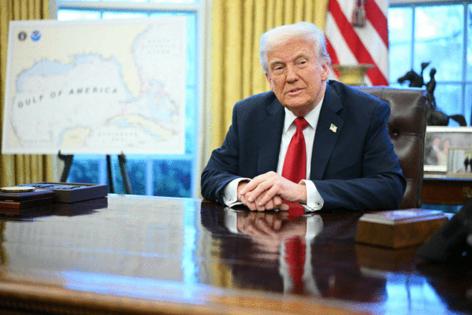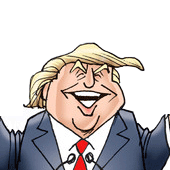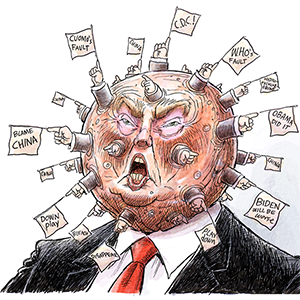Latest tariff pause shows limits of Trump's frenzied dealmaking
Published in News & Features
On “Liberation Day” on April 2, Donald Trump gushed about how trade was finally going to tilt in America’s favor after decades of its workers and companies being “plundered.” For the president, unfettered tariffs would soon make the U.S. “an entirely different country.”
Spelling out his policy of so-called reciprocity with trading partners, he said, “that means they do it to us and we do it to them, very simple, can’t get any simpler than that.”
Three months later, the transformation is proving harder and slower to execute than advertised.
As Wednesday’s tariff deadline approached with less than a handful of agreements — or mere frameworks of them — ready to announce, the Trump administration is effectively conceding that its self-imposed deadline was too optimistic for a full teardown and rebuilding of the old architecture of the U.S.-led global trading system.
This week’s move to postpone the imposition of all the April 2 duties until Aug. 1 is partly an effort to shake loose the best, final offers from economies Trump deems are still willing to deal.
“This very much reads like the final squeeze,” said Kelly Ann Shaw, a partner at Akin Gump and former senior Trump trade adviser.
But it’s also an admission of a more practical reality: that the U.S. negotiating team appeared stretched too thin to score the windfall of trade concessions Trump expected would come at the end of the 90-day tariff reprieve.
In Asia and Europe on Tuesday, equity market moves were muted amid Trump’s apparent willingness to keep negotiations going during the new extension period. U.S. stock futures gained as initial jitters over his flurry of tariff warning letters gave way to optimism about the direction of existing talks.
Deals with India, the European Union and Taiwan were nearly completed at the start of this week, according to people familiar with the matter, though anything amounting to a major breakthrough would be difficult to announce by Wednesday.
“The end game of any trade negotiation is messy and in this case the administration is negotiating with every country on earth at the same time,” said Shaw, who still expects agreements to be reached over the next three weeks. “I think many of these rates will come down as more deals close out.”
The 90-day clock was questioned by some of Trump’s trade advisers as arbitrary and unrealistic from the outset. A stock market meltdown and a maneuver by most members of his economic team — over the objection of globalization critic Peter Navarro — helped convince him in the week after April 2 that a temporary pause would force countries to the table.
And Trump, who famously likes round numbers, was once again persuaded that he should allow ongoing trade talks a bit more time to get them over the finish line.
On Monday, he declined to say the new deadline was inflexible.
Not 100%
“I would say firm but not 100% firm,” Trump said when asked if his Aug. 1 deadline was the last chance for countries to avoid the higher duties. “If they call up and say we’d like to do something a different way, we’re going to be open to that.”
The risk for the White House is that backpedaling and delays will erode Trump’s aura of speed and decisiveness.
Trump has confidently announced a number of times that he was imposing — and later temporarily pausing or lowering — duties on countries like Mexico, Canada, China, and the E.U. He has publicly bristled at how Wall Street questions his nerve with the TACO trade — from the acronym for Trump Always Chickens Out.
For countries facing his tariff hammer, though, some including the UK are choosing a level of certainty that comes with a partial deal, which outweighs the uncertainty of no agreement at all. So far they’re also refraining from retaliating against the U.S.
‘Drive up prices’
Meanwhile, the policy push-and-pull makes U.S. importers worried about the burden on households.
“While there’s a reprieve for a number of weeks, we’re going to continue to see high duties and that will drive up prices for our consumers,” Matt Priest, president and CEO with the Footwear Distributors and Retailers of America, said in a Bloomberg TV interview. “We need to understand the full bingo card before we can get back to making sourcing decisions that are critical to our businesses.”
The opportunities for more policy twists are piling up, and the stakes are only getting higher.
White House Press Secretary Karoline Leavitt on Monday sought to defend the tariff letter policy and said countries should not read the extra time as a lack of commitment to impose them.
“They will take the letters seriously because they have taken the president seriously, and that’s why the president’s phone, I can tell you, rings off the hook from world leaders all the time who are begging him to come to a deal,” she said on Monday. “And this administration is working hard to ensure those deals are in the best interest of the American people.”
Administration officials insist the effective date for the new rates will be Aug. 1 but for that to happen, Customs and Border Protection would need to start reprogramming computers accordingly — and a week or more prior to that date.
Trump also faces a mid-August deadline with Beijing where tariffs on Chinese goods could snap back to 145%. A framework hailed by his Trade Representative Jamieson Greer as great for America quickly turned into a source of frustration, as China used its leverage on rare earths to dictate the terms of the tariff truce.
“The process will continue because Trump likes it,” said Derek Scissors, a China expert at the American Enterprise Institute. “He likes to bluster, likes the attention, and he’s going to get enough wins against smaller partners to make it seem worthwhile.”
Such an approach doesn’t work on China, he said. “We can kick the trade can down the road and get more and more minor deals with small countries who will throw the U.S. a bone in order to avoid trouble,” Scissors said. “But the Chinese won’t.”
©2025 Bloomberg L.P. Visit bloomberg.com. Distributed by Tribune Content Agency, LLC.







Comments